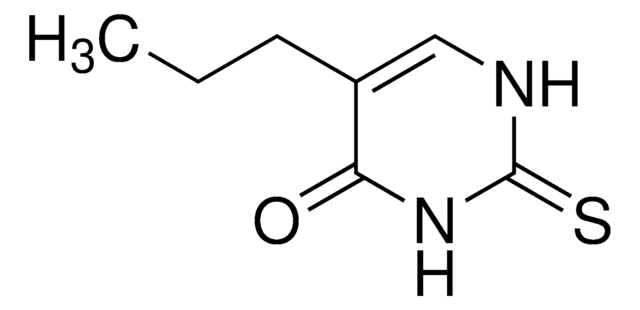P3755
6-Propyl-2-thiouracil
enzyme inhibitor
Synonyme(s) :
2,3-Dihydro-6-propyl-2-thioxo-4(1H)-pyrimidinone, 4-Hydroxy-2-mercapto-6-propylpyrimidine
About This Item
Produits recommandés
Description
enzyme inhibitor
Pureté
≥99% (HPLC)
Forme
powder
Pf
218-220 °C (lit.)
Solubilité
10% NH3: 100 mg/mL, clear to slightly hazy, colorless to faintly yellow
Chaîne SMILES
CCCC1=CC(=O)NC(=S)N1
InChI
1S/C7H10N2OS/c1-2-3-5-4-6(10)9-7(11)8-5/h4H,2-3H2,1H3,(H2,8,9,10,11)
Clé InChI
KNAHARQHSZJURB-UHFFFAOYSA-N
Informations sur le gène
human ... DIO1(1733) , TPO(7173)
Vous recherchez des produits similaires ? Visite Guide de comparaison des produits
Description générale
Application
Actions biochimiques/physiologiques
Mention d'avertissement
Warning
Mentions de danger
Conseils de prudence
Classification des risques
Acute Tox. 4 Oral - Carc. 2
Code de la classe de stockage
11 - Combustible Solids
Classe de danger pour l'eau (WGK)
WGK 3
Point d'éclair (°F)
Not applicable
Point d'éclair (°C)
Not applicable
Équipement de protection individuelle
Eyeshields, Gloves, type P3 (EN 143) respirator cartridges
Certificats d'analyse (COA)
Recherchez un Certificats d'analyse (COA) en saisissant le numéro de lot du produit. Les numéros de lot figurent sur l'étiquette du produit après les mots "Lot" ou "Batch".
Déjà en possession de ce produit ?
Retrouvez la documentation relative aux produits que vous avez récemment achetés dans la Bibliothèque de documents.
Les clients ont également consulté
Notre équipe de scientifiques dispose d'une expérience dans tous les secteurs de la recherche, notamment en sciences de la vie, science des matériaux, synthèse chimique, chromatographie, analyse et dans de nombreux autres domaines..
Contacter notre Service technique












